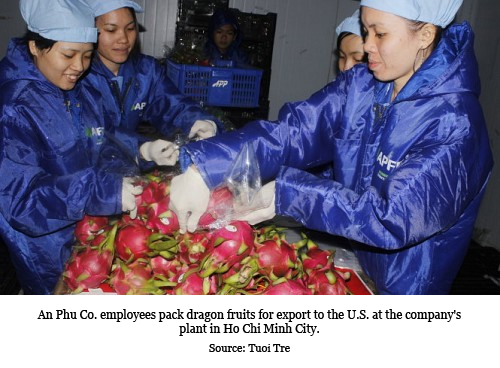Vietnam’s fruit exports to the U.S., South Korea, and Japan remain modest due to a lack of standardized products, plus unhealthy competition among local firms, even though many Vietnamese-grown tropical fruits have been allowed to enter these strict markets, statistics have shown.
 Since 2008, the U.S., Japan, South Korea, Chile, Taiwan and New Zealand have opened their doors to Vietnamese dragon fruit. Rambutan has also been accepted by these strict markets.
Since 2008, the U.S., Japan, South Korea, Chile, Taiwan and New Zealand have opened their doors to Vietnamese dragon fruit. Rambutan has also been accepted by these strict markets.
However, Vietnamese fruit exporters say they lack adequate supplies for the fruits and face fierce competition from Thailand and Taiwan.
Vietnam shipped 1,300 metric tons of dragon fruit to the U.S. in the first nine months of this year, and the full-year figure is projected to reach 2,000 metric tons, according to the Plant Protection Department under the Ministry of Agriculture and Rural Development. Dragon fruit shipments to the U.S. topped 1,300 metric tons last year.
In the meantime, Japan imported 900 metric tons of Vietnamese-grown dragon fruit in the nine-month period, a slight increase from 800 metric tons a year earlier.
Vietnamese fruit export businesses say the volumes shipped are much smaller than demand for the fruit in these markets.
Vietnam sells around 3,000 metric tons of the red-skinned fruit with white flesh to the U.S., Japan, and South Korea every year, which is less than one percent of the total exports of the fruit, according to businesses.
The Southeast Asian country still has to sell 80 percent of its dragon fruit crops to China, mostly via risky cross-border transactions.
Exports of Vietnamese rambutan to the said countries have posted even lower volumes and expanded by almost zero percent thanks to harsh competition, according to industry insiders.
‘Drop in the ocean’
The real volume of Vietnamese dragon fruit exported to the U.S. compared to the potential for development there is “just a drop in the ocean,” said Vuong Dinh Khoat, general director of Hugo Co., a fruit exporter in Ho Chi Minh City.
Khoat said the problem facing fruit exporters is that they cannot source enough standardized products to increase export quantities.
“We have provided tech support for many dragon fruit plantations, but only 10 percent of their yields are qualified for export to the U.S.,” Khoat admitted.
Nguyen Hong Hung, a former deputy director of Yasaka, a food irradiation company based in the southern province of Binh Duong, pointed out another reason behind the poor penetration of Vietnamese dragon fruit into Japan.
There are more exporters who sell dragon fruit to the East Asian country, and some of them have competed by reducing their prices, Hung said.
Yasaka was the first Vietnamese company to export dragon fruit to Japan, in 2009.
“At that time our export price was US$5 a kg, but now some local businesses ask for only $2.5 per kg,” Hung said.
Many Vietnamese catfish and rice exporters have been hurt by this unhealthy competition method, in which export prices are constantly lowered, he added.
While Vietnam used to be the only exporter of dragon fruit to Japan and the U.S., the country now faces challenges from Taiwanese and Thai competitors, according to Nguyen Huu Dat, director of the Post-Entry Plant Quarantine Center, under the Vietnamese Ministry of Agriculture and Rural Development.
Taiwan used to import thousands of metric tons of dragon fruit from Vietnam, but is now able to grow the fruit on home soil and has passed procedures to export to Japan, Dat said.
Thailand is also taking steps to export irradiated dragon fruit to the U.S., he added.
Source: Tuoi Tre News
